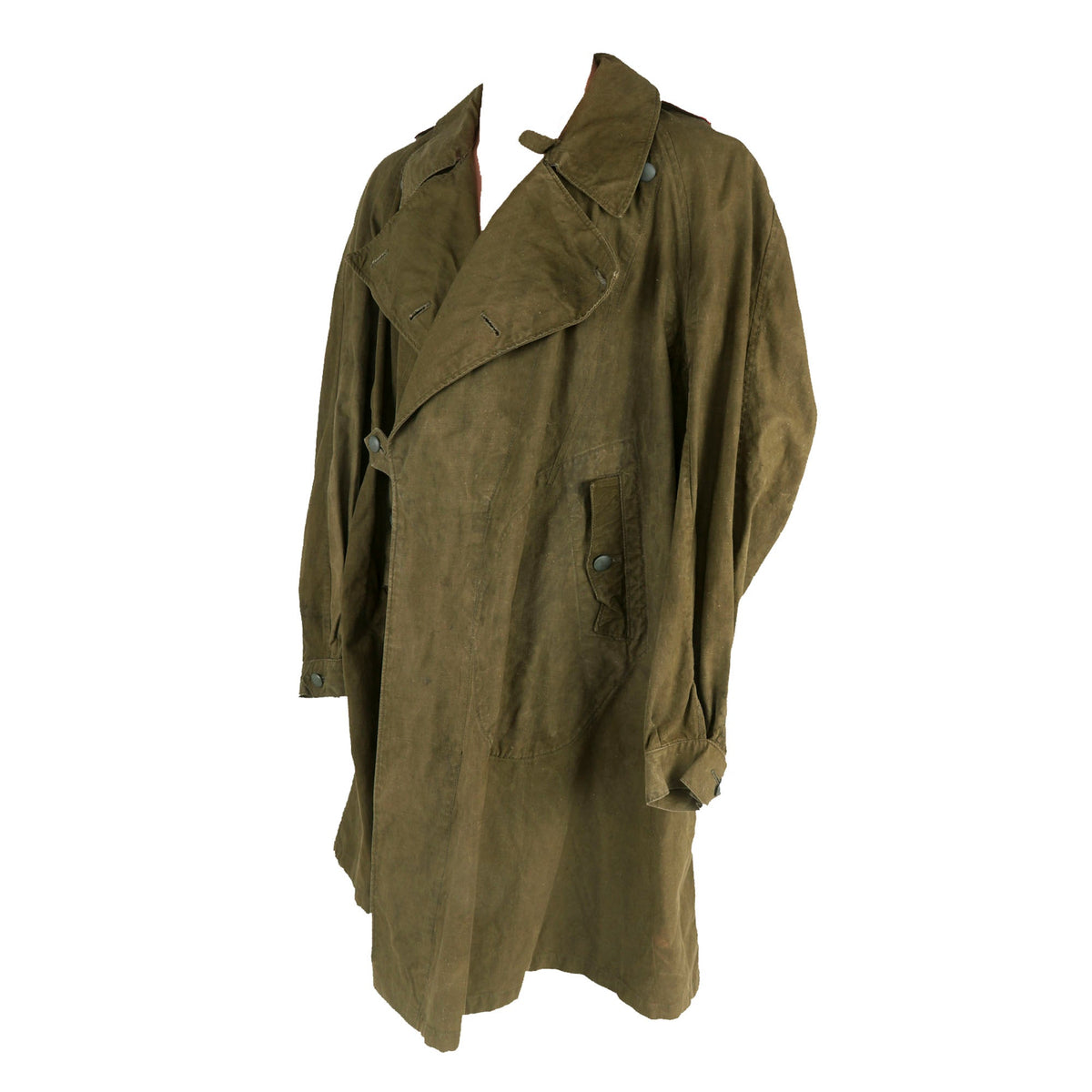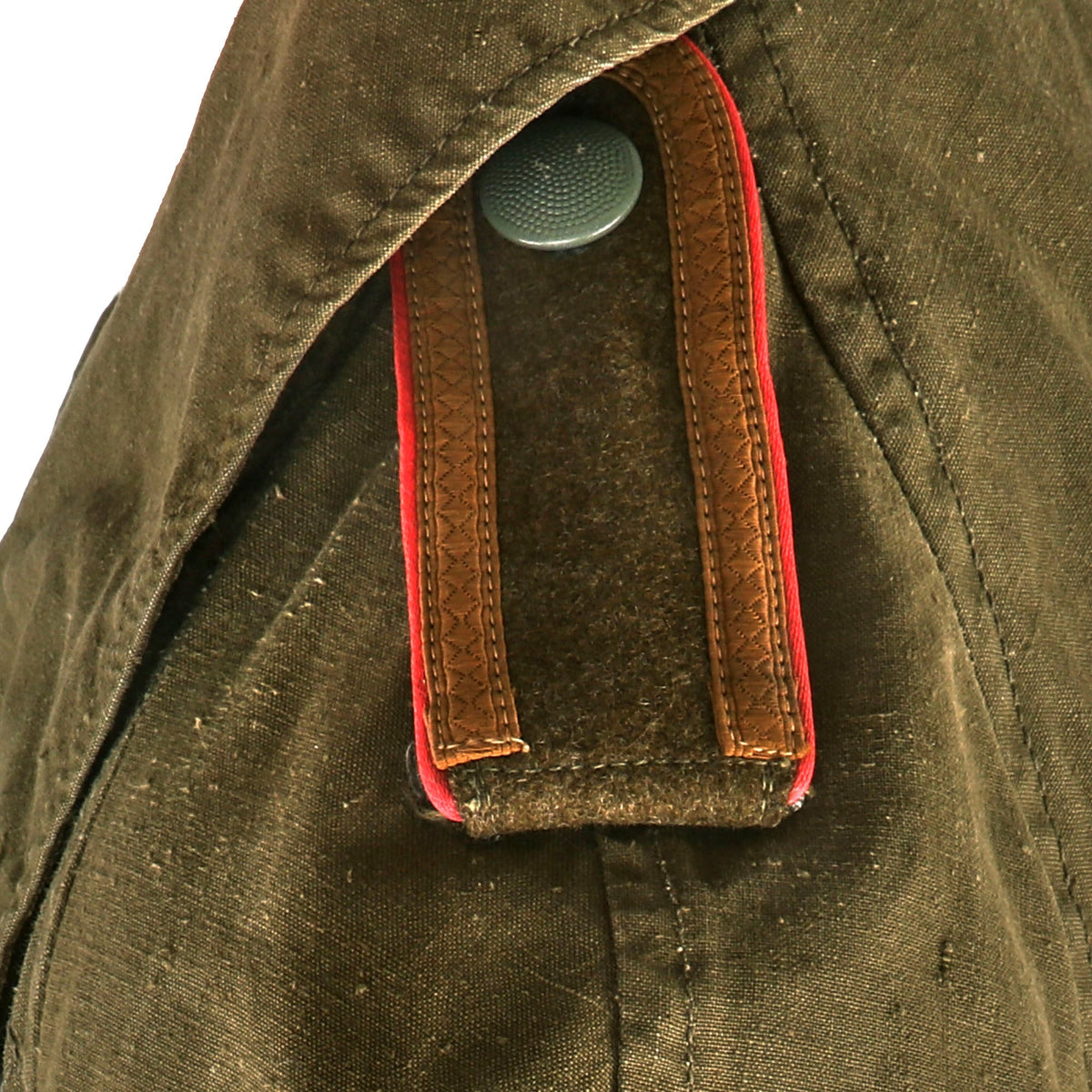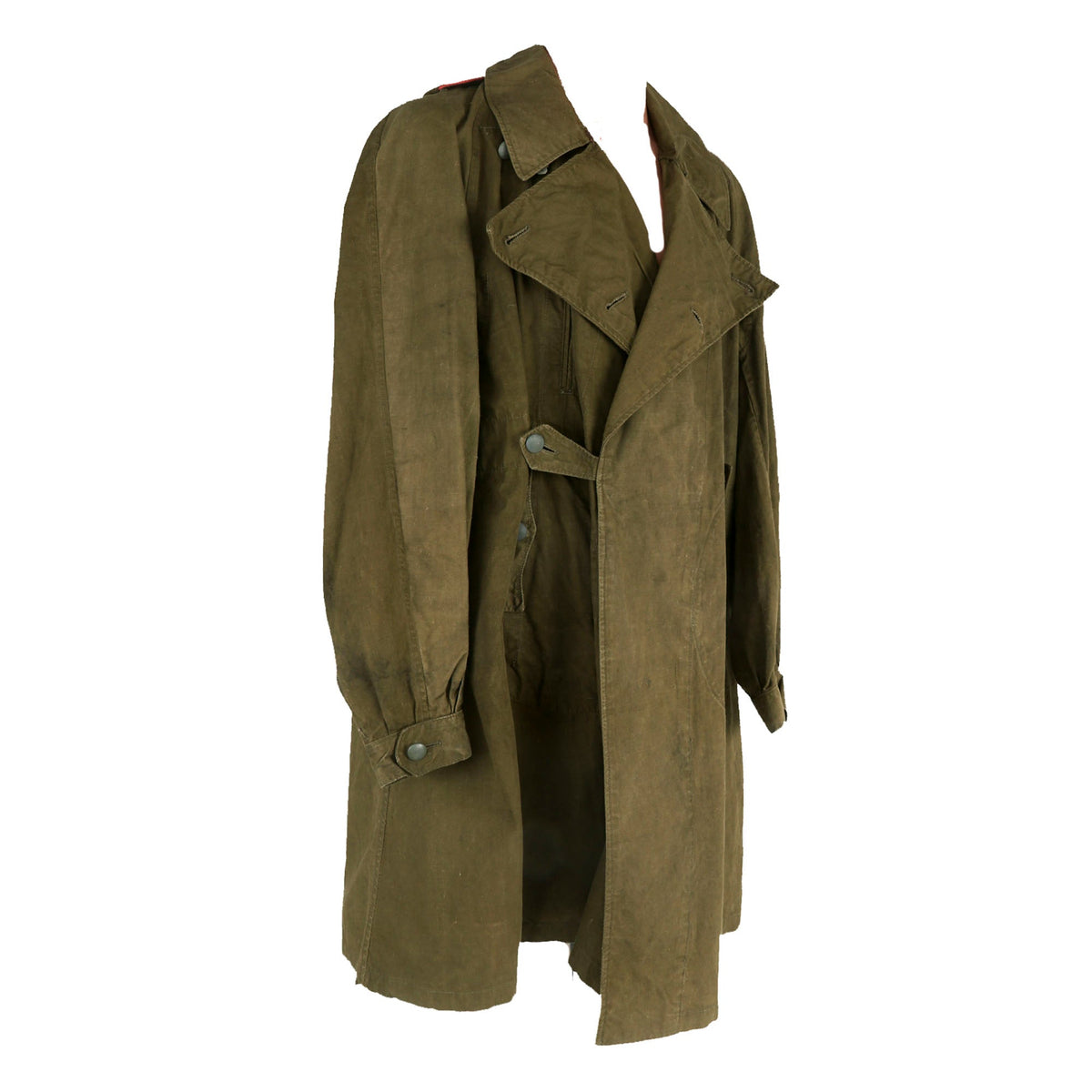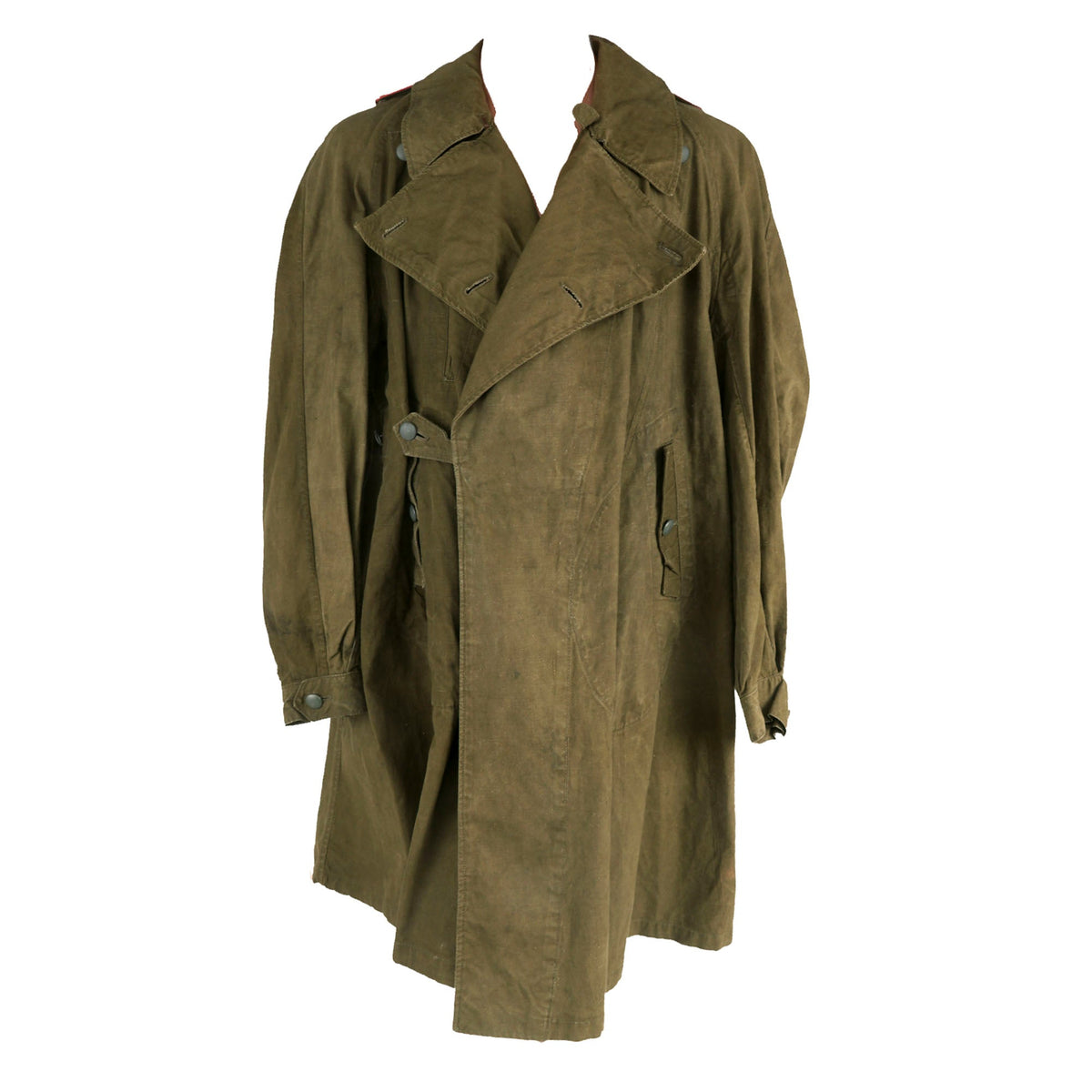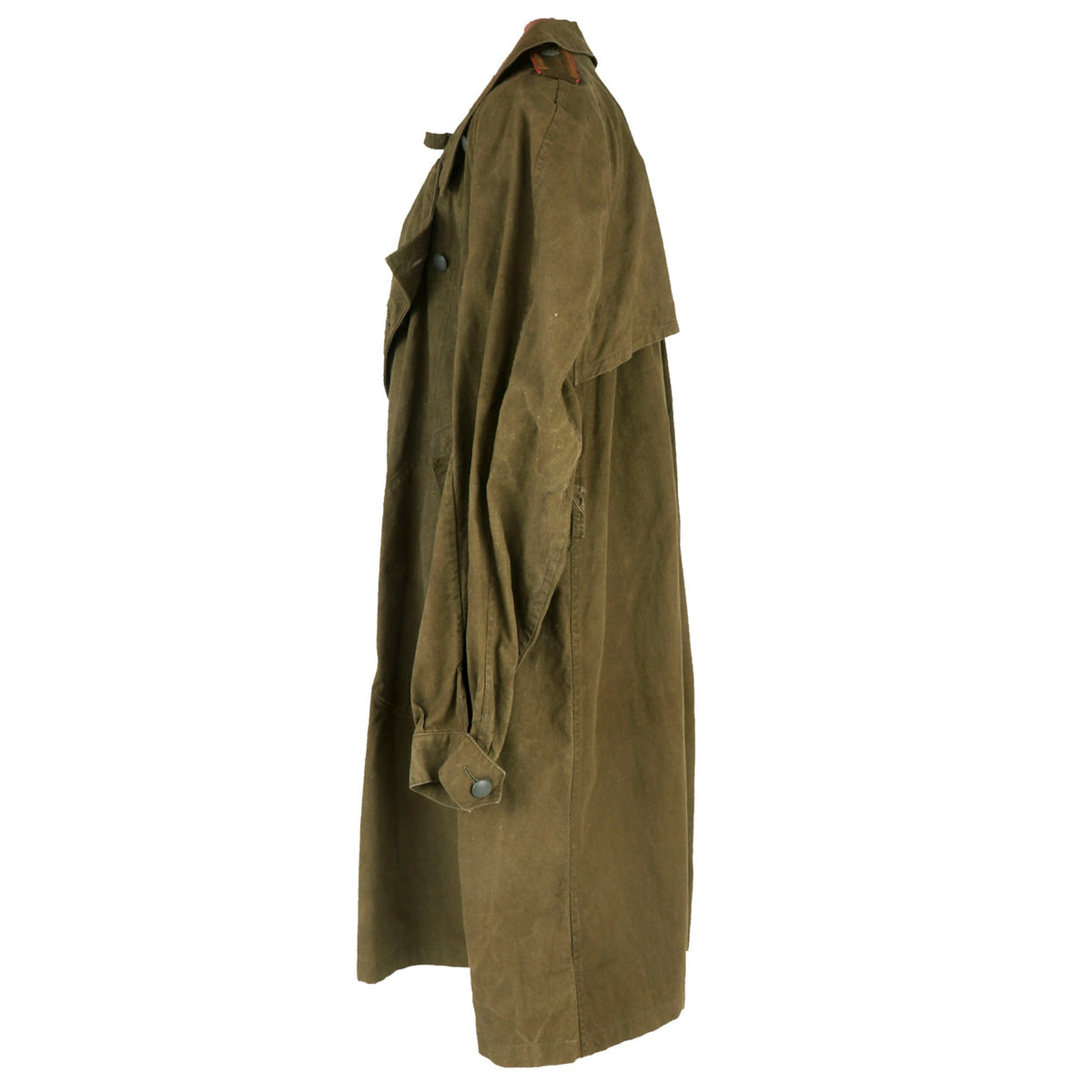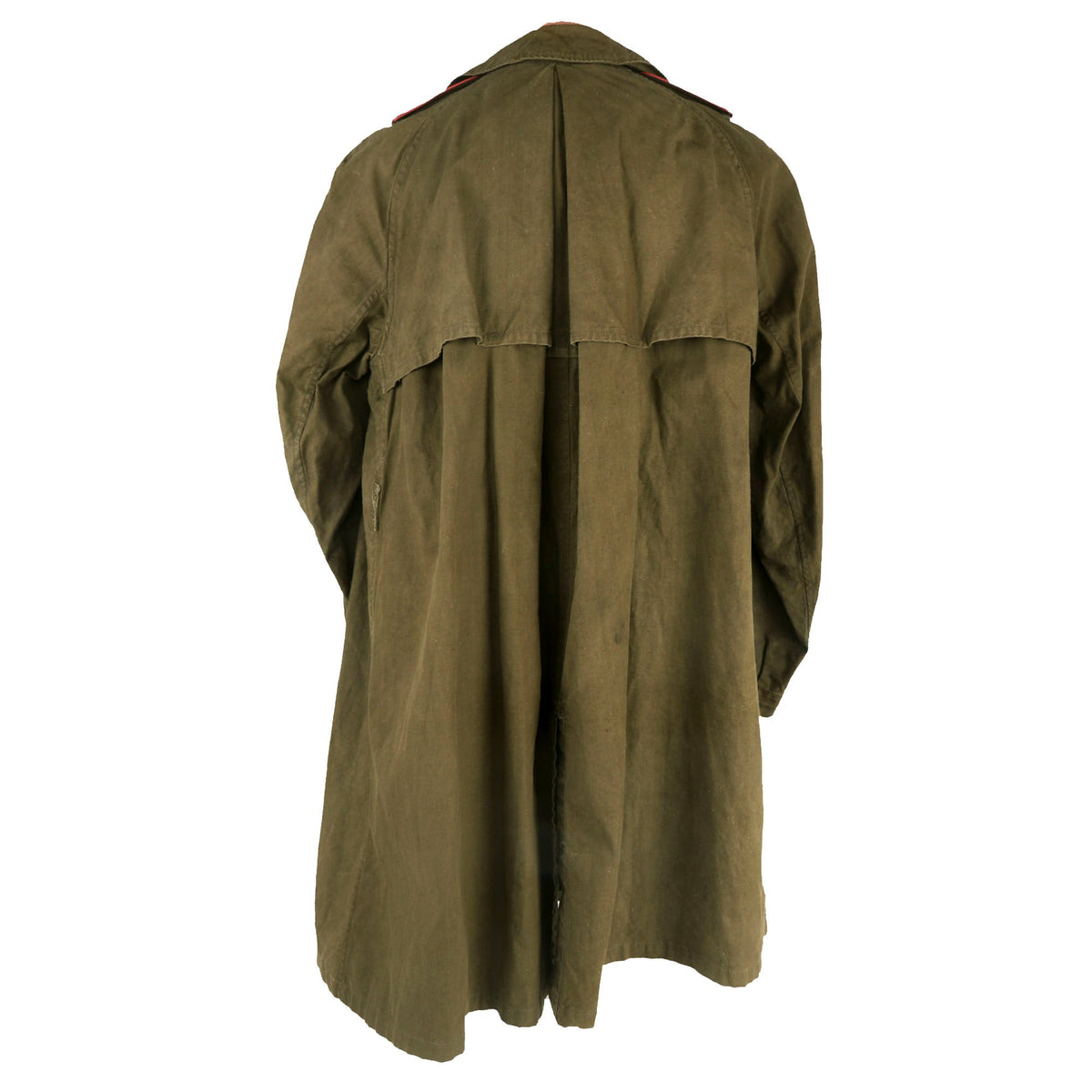Original German WWII Heer Army Panzer Reconnaissance NCO Afrikakorps DAK Tropical Kradmantel Motorcycle Overcoat – dated 1942 Original Items
$ 1.095,00 $ 273,75
Original Item: Only One Available. In early 1941, the German military began their conquest of southern Europe. Due to the warmer climates of these areas, the German Army needed to equip its troops with a more suitable form of dress, and replace the standard wool based feldgrau uniforms. The new “tropical” uniforms were lighter in weight, and dyed in colors ranging from light tan to dark olive.
This is an extremely rare DAK Tropical Kradmantel (motorcycle coat) cotton overcoat or greatcoat as used by German Army Motorcycle riders in tropical environments (Italy, Mediterranean, North Africa) during World War Two. It is heavy grade cotton manufactured with high quality and offered in very good condition. It features green painted pebbled zinc buttons that are stitched on. Some versions of these had loops for rank insignia on the shoulders, such as this example.
The button attached style NCO shoulder straps (Schulterklappen) attached to the tunic are very interesting, and look to be made specifically for use in Afrika. They have an olive wool base and securing strap, with a tan/gold woven tresse border open at the edges., indicating a rank of Unteroffizier. This is a junior NCO rank equivalent to a U.S. Army Sergeant.
The piping around the shoulder straps is Rosa (Rose Pink), the Waffenfarbe (corps color) for the the Panzertruppen (Armored Forces), as well as Kraftfahrkampftruppe – Kraftfahrtruppen (Motor Vehicle Combat Troops). Motorcycle troops were members of many different types of units, and were not specific to the Armored units during the war. From what we have read they were used for reconnaissance, as they were faster and easier to maneuver, and also used quite a bit less fuel.
The overcoat can be worn in several configurations, and has various buttons and straps on the inside and outside. There is also a hook fastener at neck to keep out the wind. Some may wonder why in the hot tropical environments an overcoat was needed, but any motorcycle rider can tell you that protection from the wind and sun are definitely needed in hot and sometimes dry environments. The water loss from air is not minor, and the overcoat actually ends up being quite a bit cooler for the rider than not wearing it, as long as you are riding.
The overcoat has lots of vents allowing air circulation, as well as a button closure on bottom rear to allow the legs to move more freely when on the vehicle. The interior is mostly unlined, but there is a mesh areas on the inside upper back, probably to keep the hot sun from that area of the back, while allowing ventilation out the large back flap. It also still retains the complete maker and size markings on the inside, which read:
Thiele & Co., München
46 52
96
131 73
M42
These markings indicate that this overcoat was processed through the München (Munich) depot during 1942.
Overall condition is very good, showing very little wear from service or fading. There is some light staining in areas, but no major deterioration or condition issues. There is no fraying of the fabric, even around the very bottom, where it would appear first, though there are a few small holes. As far as we can tell, all the buttons are still present and firmly attached. This is only the fourth time we have been able to offer this particular version of German motorcycle overcoat, and it is definitely a lovely example that would be very difficult to improve upon.
Offered in fantastic condition, this is an exceptional wartime coat that gives one heck of a silhouette when worn!
Approximate Measurements:
Collar to shoulder: 10″
Shoulder to sleeve: 26”
Shoulder to shoulder: 14.5”
Chest width: 24″
Waist width: 27″
Hip width: 34.5″
Front length: 41″
History of the German Africa Korps
The Afrika Korps or German Africa Corps (Deutsches Afrikakorps or DAK) was the German expeditionary force in Africa during the North African Campaign of World War II. First sent as a holding force to shore up the Italian defense of their African colonies, the formation fought on in Africa, under various appellations, from March 1941 until its surrender in May 1943. The term “Afrika Korps” is pseudo-German (so-called “cod-German”), deriving from an incomplete German title. The German term referred solely to the initial formation, the Deutsches Afrikakorps (DAK), which formed part of the Axis command of the German and Italian forces in North Africa. The name stuck, with both news media and Allied soldiers, as the name for all subsequent German units in North Africa. The unit is known for having been commanded by Field Marshal Erwin Rommel.
The dry climate of Africa proved to be an issue with much of the standard leather field gear that the German Army usually used. It would dry out and crack quickly, and become unusable. To deal with this, the standard field gear such as belts, Y-straps, A-frames, bayonet frogs, and other items, were issued in special tropical web versions.
Fast Shipping with Professional Packaging
Thanks to our longstanding association with UPS FedEx DHL, and other major international carriers, we are able to provide a range of shipping options. Our warehouse staff is expertly trained and will wrap your products according to our exact and precise specifications. Prior to shipping, your goods will be thoroughly examined and securely secured. We ship to thousands clients each day across multiple countries. This shows how we're dedicated to be the largest retailer on the internet. Warehouses and distribution centres can be located throughout Europe as well as the USA.
Note: Orders with more than one item will be assigned a processing date depending on the item.
Before shipping before shipping, we'll conduct a thorough inspection of the items you have ordered. Today, the majority of orders will be delivered within 48 hours. The delivery time will be between 3-7 days.
Returns
The stock is dynamic and we cannot completely manage it because multiple stakeholders are involved, including our factory and warehouse. So the actual stock may alter at any time. It's possible that you may not receive your order once the order has been made.
Our policy is valid for a period of 30 days. If you don't receive the product within 30 days, we are not able to issue a refund or an exchange.
You can only return an item if it is unused and in the same state as the day you received it. You must have the item in its original packaging.
Related products
Uncategorized
Uncategorized
Armoured Fighting Vehicles of the World: AFVs of World War One (Hardcover Book) New Made Items
Uncategorized
Uncategorized
Uncategorized
Uncategorized
Uncategorized
Angolan Rebel 1970s era 60mm Inert Display Mortar from Angolan Civil War Original Items
Uncategorized
Uncategorized
Armored Burgonet Helmet & Polearm from Scottish Castle Leith Hall Circa 1700 Original Items
Uncategorized
Australian WWII Owen MK1 Machine Carbine SMG Custom Fabricated Replica with Sling Original Items
Uncategorized
Uncategorized
Uncategorized
Uncategorized
Uncategorized
Band of Brothers ORIGINAL GERMAN WWII Le. F.H. 18 10.5cm ARTILLERY PIECE Original Items
Uncategorized
